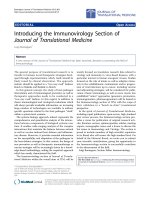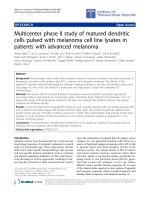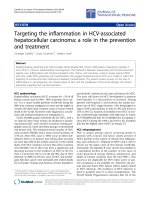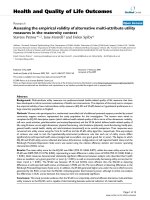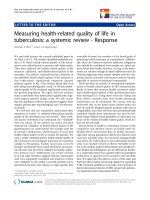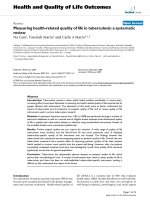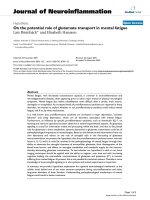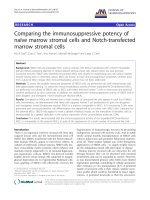Báo cáo hóa học: " Predicting the subcellular localization of viral proteins within a mammalian host cell" doc
Bạn đang xem bản rút gọn của tài liệu. Xem và tải ngay bản đầy đủ của tài liệu tại đây (312.92 KB, 8 trang )
BioMed Central
Page 1 of 8
(page number not for citation purposes)
Virology Journal
Open Access
Research
Predicting the subcellular localization of viral proteins within a
mammalian host cell
MS Scott
1
, R Oomen
2
, DY Thomas
3
and MT Hallett*
1
Address:
1
McGill Center for Bioinformatics, McGill University, 3775 University Street, Montreal, Quebec, Canada,
2
Integrated Genomics, Sanofi
Pasteur, 1755 Steeles Avenue West, Toronto, Ontario, Canada and
3
Biochemistry Department, McGill University, McIntyre Medical Sciences
Building, 3655 Promenade Sir William Osler, Montreal, Quebec, Canada
Email: MS Scott - ; R Oomen - ; DY Thomas - ;
MT Hallett* -
* Corresponding author
Abstract
Background: The bioinformatic prediction of protein subcellular localization has been extensively
studied for prokaryotic and eukaryotic organisms. However, this is not the case for viruses whose
proteins are often involved in extensive interactions at various subcellular localizations with host
proteins.
Results: Here, we investigate the extent of utilization of human cellular localization mechanisms
by viral proteins and we demonstrate that appropriate eukaryotic subcellular localization
predictors can be used to predict viral protein localization within the host cell.
Conclusion: Such predictions provide a method to rapidly annotate viral proteomes with
subcellular localization information. They are likely to have widespread applications both in the
study of the functions of viral proteins in the host cell and in the design of antiviral drugs.
Background
Viruses use the host synthetic machinery to replicate. They
have evolved mechanisms to exploit the host nucleic acid
replication and protein translation apparatus and have
also developed strategies to evade humoral immune sur-
veillance. Viral proteins require targeting to the appropri-
ate subcellular compartments of the host cell to fulfill
their roles. Viral proteins have been shown experimentally
to be localized in many different cellular compartments
including the nucleus (for example the protein kinase
encoded by Epstein-Barr Virus [1]), the nucleolus (such as
the rev and tat proteins from human immunodeficiency
virus type 1 [2]), the cytosol (for example the superoxide
dismutase-like protein from vaccinia virus [3]), the ER/
Golgi apparatus (for example, the US2 and US11 cytome-
galovirus proteins [4,5]), the plasma membrane and cell
surface (cytomegalovirus gp34 glycoprotein [6]), and the
mitochondria (M11L protein from the myxoma virus and
several others, reviewed in [7,8]). Targeting to the extracel-
lular space is also observed (for example, cowpox growth
factor [9] and the myxoma M-T7 protein [10]).
Protein subcellular localization prediction has been
widely studied (reviewed in [11,12]). Available predictors
differ in many aspects including the computational
method used, the type and diversity of protein character-
istics considered for the prediction, the localization cover-
age, the target organism(s) and the reliability. Predictors
can be grouped into four general classes based upon the
protein characteristics that are considered: amino acid
Published: 04 April 2006
Virology Journal 2006, 3:24 doi:10.1186/1743-422X-3-24
Received: 22 December 2005
Accepted: 04 April 2006
This article is available from: />© 2006 Scott et al; licensee BioMed Central Ltd.
This is an Open Access article distributed under the terms of the Creative Commons Attribution License ( />),
which permits unrestricted use, distribution, and reproduction in any medium, provided the original work is properly cited.
Virology Journal 2006, 3:24 />Page 2 of 8
(page number not for citation purposes)
composition and order based predictors [13-15], sorting
signal predictors [16,17], homology based predictors
[18,19] and hybrid methods that integrate several sources
of information to predict localization [20-23].
Although numerous protein localization predictions exist
for whole prokaryotic and eukaryotic proteomes, no such
predictions are available for many viral proteins, which
are often involved in extensive interactions with host pro-
teins in various subcellular localizations in the host cell.
This is surprising as such predictions would be of great use
in the study of infectious diseases in order to increase our
understanding of the role of these proteins in host cells
and could also be useful for the design of improved ther-
apeutic interventions.
Here, we investigate the intracellular localization predic-
tions of viral proteins in human cells. We focus on two
viruses, vaccinia virus and human cytomegalovirus,
because they infect human cells and have relatively large
but well characterized genomes. We show that these viral
proteomes harbour many known eukaryotic targeting sig-
nals and domains which probably allow them to exploit
cellular localization mechanisms. We also use the PSLT
human localization predictor [22] to demonstrate that an
appropriately chosen predictor can accurately predict the
intracellular localization of viral proteins in human cells.
Our viral subcellular localization predictions are available
as additional files.
Results
Eukaryotic targeting signals and functional domains in
specific viral proteomes
In order to investigate the extent of eukaryotic targeting
signal usage by the viral proteins considered, we scanned
the human, vaccinia virus and cytomegalovirus pro-
teomes using various bioinformatics predictors that iden-
tify these signals. To avoid redundancy in the datasets, we
considered all proteins available in UniProt [24] from one
representative strain of each virus (we chose the AD169
strain for the cytomegalovirus and the Copenhagen strain
for the vaccinia virus). As shown in Table 1, despite differ-
ences in genome size of several orders of magnitude, sev-
eral targeting signals are found to a similar extent in both
Table 1: Usage of targeting signals in human and viral proteins
Organism Human Cytomegalovirus (strain
AD169)
Vaccinia (Copenhagen strain)
Protein count 28908 192 255
Targeting signals Percentage of proteins containing signal Predictor
Signal peptide 22.0% 25.0% 12.9% SignalP [16]
Signal anchor 5.9% 8.8% 5.9% SignalP
Mitochondrial targeting
peptide
8.5% 12.0% 7.1% Predotar [40]
0 TMD
a
78.0% 66.1% 76.5% TMHMM [41]
1 TMD
a
10.0% 19.8% 16.1% TMHMM
2 TMDs
a
2.4% 5.7% 5.9% TMHMM
>2 TMDs
a
9.7% 8.3% 0.8% TMHMM
GPI anchor 2.5–3.0%
b
3.1% 2.4% GPI-SOM [42]
Prenyl group (PS00294) 0.8% 0.5% 0% Prosite [43]
NLS 13.3%
c
8.3% 2.0% PredictNLS [44]
KDEL-like (PS00014) 0.2% 0% 0% Prosite
Peroxisomal targeting
(PS00342)
2.2% 1.6% 2.8% Prosite
Most prevalent
eukaryotic functional
domains
Percentage of proteins containing domain Predictor
Immunoglobulin-like
(IPR007110)
2.7% 5.7% 2.0% InterPro [28]
Galactose oxidase
(IPR011043)
0.3% 0% 1.6% InterPro
Proteinase inhibititor I4,
serpin (IPR000215)
0.2% 0% 1.6% InterPro
Rhodopsin-like GPCR
superfamily (IPR000276)
2.8% 2.1% 0% InterPro
a
TMD: transmembrane domain
b
estimation for proportion of human proteins containing a GPI anchor from [42]
c
estimation for proportion of human proteins containing an NLS (nuclear localization signal) from [44].
Virology Journal 2006, 3:24 />Page 3 of 8
(page number not for citation purposes)
viral and human proteomes. In particular, large numbers
of these viral proteins contain N-terminal signal peptides
and anchors, consistent with the knowledge that many
glycoproteins encoded in these large viruses require entry
into the secretory pathway and have evolved to modulate
ER quality control mechanisms to ensure that large quan-
tities of viral proteins can be correctly produced and
assembled into infectious particles [25]. Similarly, a high
proportion of viral proteins are predicted to contain at
least one transmembrane domain. This reflects the high
degree of interaction of these enveloped viruses with cel-
lular membranes for functions that include assembly of
viral particles and budding of the virus [26], and thus the
need for insertion of a large proportion of their proteins
in membranes, to participate in and modulate these proc-
esses. The vaccinia virus and cytomegalovirus proteomes
also contain proteins that are predicted to harbor mito-
chondrial targeting peptides. Both cytomegalovirus and
vaccinia virus are known to encode at least one protein
that is localized to mitochondria, where they play a role in
the inhibition of apoptosis [7]. GPI anchors, which allow
the attachment of proteins to the extracellular leaflet of
the plasma membrane, are also predicted to be used by
these viral proteins, to a similar extent as by human pro-
teins. This might constitute a significant viral localization
mechanism. In contrast to the relatively large proportion
of viral proteins harbouring a C-terminal GPI-attachment
region, very few of these viral proteins are predicted to be
prenylated, which might reflect a greater need for extracel-
Table 2: Subcellular localization prediction of vaccinia virus proteins
Gene SwissProt
Accession
PSLT
predictions
a
Literature
annotations
Localization
References
Closest human
homologue
b
BLAST
e-value
A34R P21057 PM Golgi [45] C-type lectin (NP_072092) 0.02
A38L P21061 PM PM [46] CD47 antigen (NP_001768) 3E-22
A39R P21062 Secreted and PM Secreted [47] semaphorin 7A (NP_003603) 1E-30
A40R P21063 PM PM [48] lectin-like receptor (NP_031359) 2E-9
B13R P20841 Secreted Cytoplasmic [49] plasminogen activator inhibitor-2
(NP_002566)
5E-7
B15R P21116 Secreted and PM PM or secreted [50] interleukin 1 receptor (NP_775465) 4E-32
B18R P21076 Cytosolic and
nuclear
Secreted and PM [51] Ankyrin 3 isoform 1 (NP_066267) 1E-9
B5R P21115 Secreted and PM PM and Golgi [45,52,53] coagulation factor XIII B
(NP_001985)
6E-17
C12L P20531 Secreted Secreted [54] serine proteinase inhibitor
(NP_002965)
4E-47
C2L P21037 Nuclear and
cytosolic
Cytoplasmic [55] kelch-like 10 (NP_689680) 1e-024
D8L P20508 PM PM [56] carbonic anhydrase XIII (NP_940986) 8E-35
A45R P21132 Cytosolic Cytoplasmic [3] superoxide dismutase 1 (NP_000445) 3E-6
D4R P20536 Nuclear and
mitochondrial
Cytoplasmic [56] - > 0.1
D6R P20634 Nuclear Perinuclear [58] hypothetical protein (NP_060139) 0.027
E9L P20509 Nuclear Cytoplasmic [57] polymerase alpha (NP_058633) 9E-19
E3L P21081 Nuclear Nuclear [59] adenosine deaminase (NP_001102) 4E-6
F17R P68454 Cytosolic and
nuclear
Cytoplasmic [60] - > 0.1
F4L P20493 Cytosolic Cytoplasmic [57] ribonucleotide reductase M2
(NP_001025)
1E-143
A56R P20978 PM PM [61] dentin matrix acidic phosphoprotein
(NP_004398)
0.015
K1L P20632 Cytosolic and
nuclear
Cytoplasmic [62] ankyrin 2 (NP_001139) 1E-9
K2L P20532 Secreted Extracellularly
associated with
infected cell
[63] plasminogen activator inhibitor-1
(NP_000593)
3E-35
M1L P20640 Cytosolic and
nuclear
Cytoplasmic [64] ankyrin 3 (NP_066267) 4E-13
C11R P20494 PM and secreted Secreted [65] epiregulin (NP_001423) 2E-10
a
In the case of multi-compartmental proteins (proteins that are predicted with high probability to be present in more than one compartment), the
two most likely compartments were retained by PSLT. PM: plasma membrane.
b
The closest human homologue was determined by using BLAST [38] against the NCBI human RefSeq dataset. We do not report a homologue
when the BLAST e-value exceeds 0.1.
Virology Journal 2006, 3:24 />Page 4 of 8
(page number not for citation purposes)
lular rather than intracellular anchoring of these viral pro-
teins in the plasma membrane.
Nuclear localization signals (NLSs) can also be detected in
the viral proteomes. A larger proportion of cytomegalovi-
rus proteins are predicted to contain NLSs than those
encoded by the vaccinia virus genome. This is consistent
with the fact that the cytomegalovirus genome replication
as well as its viral core and capsid assembly occur in the
nucleus whereas the vaccinia virus coordinates these proc-
esses in the cytoplasm.
We also detected the presence of short targeting signals in
these proteomes. The N-terminal KDEL-like endoplasmic
reticulum (ER) retrieval motif that is present in approxi-
mately 20% of human ER lumenal proteins [27] does not
seem to be used by these viral proteins but the highly non-
specific peroxisomal-targeting signal is present to the
same extent in these viral and human proteins.
The most prevalent functional eukaryotic domains
present in these viral proteins are also shown in Table 1,
as predicted by InterPro [28]. The immunoglobulin-like
domain is the most widely used eukaryotic domain in
both cytomegalovirus and vaccinia virus, which are well
known to extensively modulate the immune response of
the host (reviewed in [29,30]). The galactose oxidase and
proteinase inhibitor I4 domains are over-represented in
vaccinia virus but absent in cytomegalovirus suggesting
that these domains are not used as part of a viral strategy
common to these two viruses but are rather specific to vac-
cinia virus. Similarly, the rhodopsin-like GPCR super-
family is prevalent in cytomegalovirus proteins but absent
from vaccinia virus. Cytomegalovirus is known to encode
at least four G-protein coupled receptors, which could
allow it to modulate and antagonize host signalling path-
ways [31].
Table 3: Subcellular localization prediction of cytomegalovirus proteins
Gene SwissProt
Accession
PSLT
predictions
a
Literature
annotations
Localization
References
Closest human homologue
b
BLAST
e-value
gp34 P16809 PM PM [6] - > 0.1
UL111A P17150 Secreted Secreted [36] interleukin 10 (NP_000563) 2E-9
UL114 P16769 Nuclear Nuclear [66] uracil-DNA glycosylase
(NP_550433)
5E-39
UL118/119 P16739 PM PM [6] - > 0.1
UL18 P08560 PM/secreted PM [67] MHC class Ib antigen
(NP_005507)
4E-16
UL33 P16849 PM PM, endosomes,
secretory
pathway,
perinuclear
[34,68] chemokine receptor 1
(NP_001286)
3E-21
UL48 P16785 Cytosolic and ER ER, cytosolic,
vacuolar
[69,70] spen homolog, transcriptional
regulator (NP_055816)
0.082
UL54 P08546 Nuclear Nuclear [71] polymerase delta 1 (NP_002682) 3E-50
UL78 P16751 PM PM [34] somatostatin receptor 3
(NP_001042)
0.006
UL97 P16788 PM, cytosolic Golgi, nuclear and
cytosolic
[72] - > 0.1
US10 P09728 PM ER [33] - > 0.1
US11 P09727 PM ER [4] - > 0.1
US2 P09713 PM ER and cytosolic [5] - > 0.1
US27 P09703 PM PM, endosomes,
secretory
pathway,
perinuclear
[34,68] chemokine receptor 1
(NP_001328)
7E-31
US28 P69332 PM PM, endosomes [34,68] chemokine receptor 1
(NP_001328)
2E-55
US3 P09712 PM ER [73,74] - > 0.1
US6 P14334 PM ER [75] - > 0.1
US7 P09731 PM ER [33] - > 0.1
US8 P09730 PM Golgi [33] - > 0.1
US9 P09729 Secreted ER [33] - > 0.1
a
In the case of multi-compartmental proteins (proteins that are predicted with high probability to be present in more than one compartment), the
two most likely compartments were retained by PSLT. PM: plasma membrane; ER: endoplasmic reticulum.
b
The closest human homologue was determined by using BLAST [38] against the NCBI human RefSeq dataset. We do not report a homologue
when the BLAST e-value exceeds 0.1.
Virology Journal 2006, 3:24 />Page 5 of 8
(page number not for citation purposes)
Interestingly, protein-protein interaction domains such as
SH2, SH3, WW and t-snare domains are conspicuously
absent from these viral proteomes (data not shown), indi-
cating that mimicry and modulation of this type of cellu-
lar communication mechanism might not be part of the
survival strategy of these viruses.
The very high proportion of viral proteins containing one
or several eukaryotic targeting motifs and functional
domains shows the extensive usage of cellular localization
mechanisms and machinery by these viruses. This pro-
vides a good indication that eukaryotic protein subcellu-
lar localization predictors might perform well on these
viruses.
Subcellular localization prediction of viral proteins in host
cells
We used the PSLT human subcellular localization predic-
tor [22] to predict the localization of cytomegalovirus and
vaccinia virus proteins and to investigate whether princi-
ples of eukaryotic protein localization prediction can be
applied to viral proteins. PSLT is a Bayesian network type
tool, trained on human sequences, that predicts the sub-
cellular localization of proteins based on the co-occur-
rence of protein domains, motifs and targeting signals.
Table 2 shows the predictions of vaccinia virus proteins
whose cellular localization has already been studied
experimentally and is available in the literature (the full
prediction dataset is available as supplementary material,
please see Additional file 1). As shown in Table 2, the
localization of most vaccinia virus proteins is well-pre-
dicted. The accuracy of PSLT on this dataset can be esti-
mated to be 78% (proteins localized to more than one
compartment are considered to be accurately predicted if
at least one predicted compartment agrees with the previ-
ous literature annotation). A large proportion (36%) of
these proteins are predicted to be secreted or expressed on
the cell surface as integral membrane proteins or mem-
brane anchored proteins. For the most part, this predic-
tion is confirmed in the literature, but it should be
considered a conservative estimate, since experimental
studies cannot always sample the kinetics of viral protein
synthesis and trafficking in all systems under all condi-
tions. This estimate of extracellular and cell surface viral
proteins is higher than our estimate of 22% for human
cellular proteins [22], and likely reflects important viral
functions that require using the host secretory pathway.
Indeed, several of these proteins are known to be involved
in modulating the host immune response including
secreted proteins that bind chemokines, interferons and
interleukin family members [30,32]. Other such proteins
are incorporated in the viral envelope. Few or no vaccinia
proteins are predicted to localize to the peroxisome, lyso-
some, ER or Golgi apparatus.
Table 3 shows the PSLT predictions for cytomegalovirus
proteins whose cellular localization has already been
studied experimentally and is available in the literature
(the full prediction dataset is available as supplementary
material, please see Additional file 2). The prediction
accuracy of PSLT on this dataset is estimated to be 60%
according to the literature. Almost all proteins classified as
wrongly predicted according to the literature are anno-
tated as localized in the ER or Golgi apparatus but pre-
dicted by PSLT as being on the cell surface. Several of these
proteins display characteristics of cell surface or secreted
proteins such as the capability to bind MHC class I and
class II antigens. However, instead of being secreted, these
cytomegalovirus proteins localize to the ER where they
bind the MHC antigens, effectively targeting them for deg-
radation and leading to the protection of cytomegalovi-
rus-infected cells from CD8+ and CD4+ T lymphocytes
[33]. Many other cytomegalovirus proteins are well-pre-
dicted including cell surface receptors, several of which
mimic host receptors [34] as well as secreted proteins such
as viral chemokine and IL-10 homologues [35,36].
We investigated whether the prediction accuracy of PSLT
was correlated with the degree of similarity between the
viral proteins and their closest human homologue. The
two rightmost columns of Tables 2 and 3 show the closest
human homologue from the NCBI RefSeq [37] database
for each viral protein, as determined by BLAST [38]. In
general, viral proteins that have close human homologues
(BLAST e-value <= 1e-10) are accurately predicted by
PSLT. The prediction accuracy for these proteins is 100%
for the cytomegalovirus and 91% for the vaccinia virus.
Some viral proteins that do not have close human homo-
logues (BLAST e-value > 1e-10) are well-predicted but the
overall prediction accuracy of PSLT for these proteins is
lower (43% for cytomegalovirus proteins and 67% for
vaccinia virus proteins). This is consistent with previous
analyses which allowed us to show that the prediction
accuracy of PSLT is greater when predicting proteins from
organisms that are evolutionarily close to those used to
train the predictor [22].
Discussion
The proteomes of vaccinia virus and cytomegalovirus dis-
play numerous examples of eukaryotic targeting signals
and functional domains, consistent with their evolution-
ary origin and their extensive usage of many elements of
the host cellular machinery. We show here that, as a con-
sequence, the subcellular localization of these viral pro-
teins can be accurately predicted by human protein
localization predictors. We used the PSLT predictor which
considers the combinatorial presence of domains and tar-
geting signals in human proteins to predict localization.
This predictor might be better-suited for this task than
other types of localization predictors. Indeed, PSLT specif-
Virology Journal 2006, 3:24 />Page 6 of 8
(page number not for citation purposes)
ically focuses on the localization of human proteins and
has been shown to accurately predict the localization of
mammalian proteins in general and thus is likely an
appropriate choice for the prediction of the localization of
viral proteins within human cells. Another advantage of
PSLT is that it considers domains and motifs rather than
amino acid composition. Many of these domains and
motifs are likely involved in interactions with host pro-
teins and should thus more closely resemble human
sequences than other regions of the proteins. In fact, sev-
eral of these domains are believed to have been stolen by
these large viruses from host cells [39]. Viral-specific pro-
teins might have evolved to resemble host protein motifs,
in order to use mechanisms available in host cells. Not
surprisingly, viral proteins that have a high degree of sim-
ilarity to human proteins are generally better predicted
than those that do not have a close human homologue.
More extensive research into viral subcellular localization
prediction will likely lead to higher prediction accuracy
and coverage as the specific non-eukaryotic characteristics
of viral proteins can also be exploited to determine their
cellular localization. This will likely be particularly impor-
tant to predict the localization of viral proteins that have
little similarity to mammalian proteins.
Conclusion
This study demonstrates that eukaryotic protein subcellu-
lar localization predictors can be used to rapidly annotate
specific viral proteomes with a first and reasonably accu-
rate estimate of intracellular localization. The subcellular
localization prediction of viral proteins within human
cells should be of great utility to the biological commu-
nity to increase our understanding of the function of these
proteins, of their role in the cell and of the consequences
of host-pathogen interactions. They might also serve to
devise more efficient methods of treatment by rapid iden-
tification of targets.
Methods
28908 human protein sequences were retrieved from the
Hera database [27]. These proteins represent all NCBI Ref-
Seq [37] entries currently present in Hera. Cytomegalovi-
rus and vaccinia virus protein sequences were
downloaded from UniProt [24]. All sequences were
scanned with the different predictors referred to in Table
1, using the default parameters.
The localization of the viral proteins was predicted using
PSLT as previously described [22]. PSLT is a Bayesian net-
work type tool that predicts the subcellular localization of
proteins based on the co-occurrence of protein domains,
motifs and targeting signals. PSLT was trained on human
proteins as described in [22]. In the case of multi-com-
partmental proteins (proteins that are predicted with high
probability to be present in more than one compart-
ment), the two most likely compartments were retained.
The closest homologue of all viral proteins in Tables 2 and
3 was determined by using BLASTP version 2.2.12 [38]
against the NCBI human RefSeq dataset (release 15) [37].
The default parameters of BLASTP were used.
Additional materialAcknowledgements
We wish to thank François Pepin for logistical support. This work was sup-
ported by grants to D.Y.T. and M.H. from Genome Quebec/Genome Can-
ada as well as to D.Y.T. from the Canadian Institutes of Health Research
(CIHR). M.S.S. is a recipient of a Canada Graduate Scholarship (CGS) Doc-
toral Award from CIHR.
References
1. Gershburg E, Marschall M, Hong K, Pagano JS: Expression and
localization of the Epstein-Barr virus-encoded protein
kinase. J Virol 2004, 78:12140-12146.
2. Miyazaki Y, Takamatsu T, Nosaka T, Fujita S, Martin TE, Hatanaka M:
The cytotoxicity of human immunodeficiency virus type 1
Rev: implications for its interaction with the nucleolar pro-
tein B23. Exp Cell Res 1995, 219:93-101.
3. Almazan F, Tscharke DC, Smith GL: The vaccinia virus superox-
ide dismutase-like protein (A45R) is a virion component that
is nonessential for virus replication. J Virol 2001, 75:7018-7029.
4. Lilley BN, Ploegh HL: A membrane protein required for dislo-
cation of misfolded proteins from the ER. Nature 2004,
429:834-840.
5. Wiertz EJ, Tortorella D, Bogyo M, Yu J, Mothes W, Jones TR, Rap-
oport TA, Ploegh HL: Sec61-mediated transfer of a membrane
protein from the endoplasmic reticulum to the proteasome
for destruction. Nature 1996, 384:432-438.
6. Atalay R, Zimmermann A, Wagner M, Borst E, Benz C, Messerle M,
Hengel H: Identification and expression of human cytomega-
lovirus transcription units coding for two distinct Fcgamma
receptor homologs. J Virol 2002, 76:8596-8608.
7. Boya P, Pauleau AL, Poncet D, Gonzalez-Polo RA, Zamzami N, Kro-
emer G: Viral proteins targeting mitochondria: controlling
cell death. Biochim Biophys Acta 2004, 1659:178-189.
8. Everett H, McFadden G: Viruses and apoptosis: meddling with
mitochondria. Virology 2001, 288:1-7.
9. da Fonseca FG, Silva RL, Marques JT, Ferreira PC, Kroon EG: The
genome of cowpox virus contains a gene related to those
encoding the epidermal growth factor, transforming growth
factor alpha and vaccinia growth factor. Virus Genes 1999,
18:151-160.
10. Upton C, Mossman K, McFadden G: Encoding of a homolog of the
IFN-gamma receptor by myxoma virus. Science 1992,
258:1369-1372.
Additional File 1
which contains protein localization predictions for several different strains
of the vaccinia virus.
Click here for file
[ />422X-3-24-S1.xls]
Additional File 2
which contains protein localization predictions for several different strains
of the human cytomegalovirus
Click here for file
[ />422X-3-24-S2.xls]
Virology Journal 2006, 3:24 />Page 7 of 8
(page number not for citation purposes)
11. Donnes P, Hoglund A: Predicting protein subcellular localiza-
tion: past, present, and future. Genomics Proteomics Bioinformatics
2004, 2:209-215.
12. Feng ZP: An overview on predicting the subcellular location of
a protein. In Silico Biol 2002, 2:291-303.
13. Reinhardt A, Hubbard T: Using neural networks for prediction
of the subcellular location of proteins. Nucleic Acids Res 1998,
26:2230-2236.
14. Hua S, Sun Z: Support vector machine approach for protein
subcellular localization prediction. Bioinformatics 2001,
17:721-728.
15. Chou KC: Prediction of protein cellular attributes using
pseudo-amino acid composition. Proteins 2001, 43:246-255.
16. Bendtsen JD, Nielsen H, von Heijne G, Brunak S: Improved predic-
tion of signal peptides: SignalP 3.0. J Mol Biol 2004, 340:783-795.
17. Emanuelsson O, Nielsen H, Brunak S, von Heijne G: Predicting sub-
cellular localization of proteins based on their N-terminal
amino acid sequence. J Mol Biol 2000, 300:1005-1016.
18. Marcotte EM, Xenarios I, van Der Bliek AM, Eisenberg D: Localizing
proteins in the cell from their phylogenetic profiles. Proc Natl
Acad Sci U S A 2000, 97:12115-12120.
19. Lu Z, Szafron D, Greiner R, Lu P, Wishart DS, Poulin B, Anvik J, Mac-
donell C, Eisner R: Predicting subcellular localization of pro-
teins using machine-learned classifiers. Bioinformatics 2004,
20:547-556.
20. Nakai K, Kanehisa M: A knowledge base for predicting protein
localization sites in eukaryotic cells. Genomics 1992,
14:897-911.
21. Drawid A, Gerstein M: A Bayesian system integrating expres-
sion data with sequence patterns for localizing proteins:
comprehensive application to the yeast genome. J Mol Biol
2000, 301:1059-1075.
22. Scott MS, Thomas DY, Hallett MT: Predicting subcellular locali-
zation via protein motif co-occurrence. Genome Res 2004,
14:1957-1966.
23. Hoglund A, Donnes P, Blum T, Adolph HW, Kohlbacher O: Multi-
Loc: prediction of protein subcellular localization using N-
terminal targeting sequences, sequence motifs, and amino
acid composition. Bioinformatics 2006.
24. Bairoch A, Apweiler R, Wu CH, Barker WC, Boeckmann B, Ferro S,
Gasteiger E, Huang H, Lopez R, Magrane M, Martin MJ, Natale DA,
O'Donovan C, Redaschi N, Yeh LS: The Universal Protein
Resource (UniProt). Nucleic Acids Res 2005, 33:D154-9.
25. Maggioni C, Braakman I: Synthesis and quality control of viral
membrane proteins. Curr Top Microbiol Immunol 2005,
285:175-198.
26. Chazal N, Gerlier D: Virus entry, assembly, budding, and mem-
brane rafts. Microbiol Mol Biol Rev 2003, 67:226-237.
27. Scott M, Lu G, Hallett M, Thomas DY: The Hera database and its
use in the characterization of endoplasmic reticulum pro-
teins. Bioinformatics 2004, 20:937-944.
28. Mulder NJ, Apweiler R, Attwood TK, Bairoch A, Barrell D, Bateman
A, Binns D, Biswas M, Bradley P, Bork P, Bucher P, Copley RR, Cour-
celle E, Das U, Durbin R, Falquet L, Fleischmann W, Griffiths-Jones S,
Haft D, Harte N, Hulo N, Kahn D, Kanapin A, Krestyaninova M,
Lopez R, Letunic I, Lonsdale D, Silventoinen V, Orchard SE, Pagni M,
Peyruc D, Ponting CP, Selengut JD, Servant F, Sigrist CJ, Vaughan R,
Zdobnov EM: The InterPro Database, 2003 brings increased
coverage and new features. Nucleic Acids Res 2003, 31:315-318.
29. Mocarski ESJ: Immune escape and exploitation strategies of
cytomegaloviruses: impact on and imitation of the major his-
tocompatibility system. Cell Microbiol 2004, 6:707-717.
30. Smith GL, Symons JA, Alcami A: Immune modulation by proteins
secreted from cells infected by vaccinia virus. Arch Virol Suppl
1999, 15:111-129.
31. Stropes MP, Miller WE: Signaling and regulation of G-protein
coupled receptors encoded by cytomegaloviruses. Biochem
Cell Biol 2004, 82:636-642.
32. Dunlop LR, Oehlberg KA, Reid JJ, Avci D, Rosengard AM: Variola
virus immune evasion proteins. Microbes Infect 2003,
5:1049-1056.
33. Huber MT, Tomazin R, Wisner T, Boname J, Johnson DC: Human
cytomegalovirus US7, US8, US9, and US10 are cytoplasmic
glycoproteins, not found at cell surfaces, and US9 does not
mediate cell-to-cell spread. J Virol 2002, 76:5748-5758.
34. Michelson S: Consequences of human cytomegalovirus mim-
icry. Hum Immunol 2004, 65:465-475.
35. Penfold ME, Dairaghi DJ, Duke GM, Saederup N, Mocarski ES, Kemble
GW, Schall TJ: Cytomegalovirus encodes a potent alpha chem-
okine. Proc Natl Acad Sci U S A 1999, 96:9839-9844.
36. Kotenko SV, Saccani S, Izotova LS, Mirochnitchenko OV, Pestka S:
Human cytomegalovirus harbors its own unique IL-10
homolog (cmvIL-10). Proc Natl Acad Sci U S A 2000, 97:1695-1700.
37. Pruitt KD, Tatusova T, Maglott DR: NCBI Reference Sequence
(RefSeq): a curated non-redundant sequence database of
genomes, transcripts and proteins. Nucleic Acids Res 2005,
33:D501-4.
38. Altschul SF, Madden TL, Schaffer AA, Zhang J, Zhang Z, Miller W, Lip-
man DJ: Gapped BLAST and PSI-BLAST: a new generation of
protein database search programs. Nucleic Acids Res 1997,
25:3389-3402.
39. Chensue SW: Molecular machinations: chemokine signals in
host-pathogen interactions. Clin Microbiol Rev 2001, 14:821-835.
40. Small I, Peeters N, Legeai F, Lurin C: Predotar: A tool for rapidly
screening proteomes for N-terminal targeting sequences.
Proteomics 2004, 4:1581-1590.
41. Krogh A, Larsson B, von Heijne G, Sonnhammer EL: Predicting
transmembrane protein topology with a hidden Markov
model: application to complete genomes. J Mol Biol 2001,
305:567-580.
42. Fankhauser N, Maser P: Identification of GPI anchor attach-
ment signals by a Kohonen self-organizing map. Bioinformatics
2005, 21:1846-1852.
43. Hulo N, Sigrist CJ, Le Saux V, Langendijk-Genevaux PS, Bordoli L,
Gattiker A, De Castro E, Bucher P, Bairoch A: Recent improve-
ments to the PROSITE database. Nucleic Acids Res 2004,
32:D134-7.
44. Cokol M, Nair R, Rost B: Finding nuclear localization signals.
EMBO Rep 2000, 1:411-415.
45. Lorenzo MM, Galindo I, Griffiths G, Blasco R: Intracellular locali-
zation of vaccinia virus extracellular enveloped virus enve-
lope proteins individually expressed using a Semliki Forest
virus replicon. J Virol 2000, 74:10535-10550.
46. Sanderson CM, Parkinson JE, Hollinshead M, Smith GL: Overexpres-
sion of the vaccinia virus A38L integral membrane protein
promotes Ca2+ influx into infected cells. J Virol 1996,
70:905-914.
47. Gardner JD, Tscharke DC, Reading PC, Smith GL: Vaccinia virus
semaphorin A39R is a 50-55 kDa secreted glycoprotein that
affects the outcome of infection in a murine intradermal
model. J Gen Virol 2001, 82:2083-2093.
48. Wilcock D, Duncan SA, Traktman P, Zhang WH, Smith GL: The vac-
cinia virus A4OR gene product is a nonstructural, type II
membrane glycoprotein that is expressed at the cell surface.
J Gen Virol 1999, 80 ( Pt 8):2137-2148.
49. Kettle S, Blake NW, Law KM, Smith GL: Vaccinia virus serpins
B13R (SPI-2) and B22R (SPI-1) encode M(r) 38.5 and 40K,
intracellular polypeptides that do not affect virus virulence
in a murine intranasal model. Virology 1995, 206:136-147.
50. Danescu J, Werenskiold AK: Post-transcriptional inhibition of
the interleukin-1 binding protein B15R of vaccinia virus after
coexpression of the related T1 protein. FEBS Lett 1995,
367:89-92.
51. Colamonici OR, Domanski P, Sweitzer SM, Larner A, Buller RM: Vac-
cinia virus B18R gene encodes a type I interferon-binding
protein that blocks interferon alpha transmembrane signal-
ing. J Biol Chem 1995, 270:15974-15978.
52. Meiser A, Sancho C, Krijnse Locker J: Plasma membrane budding
as an alternative release mechanism of the extracellular
enveloped form of vaccinia virus from HeLa cells. J Virol 2003,
77:9931-9942.
53. Engelstad M, Smith GL: The vaccinia virus 42-kDa envelope pro-
tein is required for the envelopment and egress of extracel-
lular virus and for virus virulence. Virology 1993, 194:627-637.
54. Symons JA, Adams E, Tscharke DC, Reading PC, Waldmann H, Smith
GL: The vaccinia virus C12L protein inhibits mouse IL-18 and
promotes virus virulence in the murine intranasal model. J
Gen Virol 2002, 83:2833-2844.
55. Pires de Miranda M, Reading PC, Tscharke DC, Murphy BJ, Smith GL:
The vaccinia virus kelch-like protein C2L affects calcium-
independent adhesion to the extracellular matrix and
Publish with BioMed Central and every
scientist can read your work free of charge
"BioMed Central will be the most significant development for
disseminating the results of biomedical research in our lifetime."
Sir Paul Nurse, Cancer Research UK
Your research papers will be:
available free of charge to the entire biomedical community
peer reviewed and published immediately upon acceptance
cited in PubMed and archived on PubMed Central
yours — you keep the copyright
Submit your manuscript here:
/>BioMedcentral
Virology Journal 2006, 3:24 />Page 8 of 8
(page number not for citation purposes)
inflammation in a murine intradermal model. J Gen Virol 2003,
84:2459-2471.
56. Maa JS, Rodriguez JF, Esteban M: Structural and functional char-
acterization of a cell surface binding protein of vaccinia virus.
J Biol Chem 1990, 265:1569-1577.
57. Beaud G: Vaccinia virus DNA replication: a short review. Bio-
chimie 1995, 77:774-779.
58. Hu X, Wolffe EJ, Weisberg AS, Carroll LJ, Moss B: Repression of
the A8L gene, encoding the early transcription factor 82-
kilodalton subunit, inhibits morphogenesis of vaccinia viri-
ons. J Virol 1998, 72:104-112.
59. Yuwen H, Cox JH, Yewdell JW, Bennink JR, Moss B: Nuclear local-
ization of a double-stranded RNA-binding protein encoded
by the vaccinia virus E3L gene. Virology 1993, 195:732-744.
60. Reckmann I, Higley S, Way M: The vaccinia virus F17R protein
interacts with actin. FEBS Lett 1997, 409:141-146.
61. Brown CK, Turner PC, Moyer RW: Molecular characterization
of the vaccinia virus hemagglutinin gene. J Virol 1991,
65:3598-3606.
62. Bradley RR, Terajima M: Vaccinia virus K1L protein mediates
host-range function in RK-13 cells via ankyrin repeat and
may interact with a cellular GTPase-activating protein. Virus
Res 2005.
63. Turner PC, Baquero MT, Yuan S, Thoennes SR, Moyer RW: The
cowpox virus serpin SPI-3 complexes with and inhibits urok-
inase-type and tissue-type plasminogen activators and plas-
min. Virology 2000, 272:267-280.
64. Xiang Y, Simpson DA, Spiegel J, Zhou A, Silverman RH, Condit RC:
The vaccinia virus A18R DNA helicase is a postreplicative
negative transcription elongation factor. J Virol 1998,
72:7012-7023.
65. Kim HS, Lee YH, Min DS, Chang JS, Ryu SH, Ahn BY, Suh PG: Tyro-
sine phosphorylation of phospholipase C-gamma 1 by vac-
cinia virus growth factor. Virology 1995, 214:21-28.
66. Prichard MN, Lawlor H, Duke GM, Mo C, Wang Z, Dixon M, Kemble
G, Kern ER: Human cytomegalovirus uracil DNA glycosylase
associates with ppUL44 and accelerates the accumulation of
viral DNA. Virol J 2005, 2:55.
67. Cosman D, Fanger N, Borges L, Kubin M, Chin W, Peterson L, Hsu
ML: A novel immunoglobulin superfamily receptor for cellu-
lar and viral MHC class I molecules. Immunity 1997, 7:273-282.
68. Fraile-Ramos A, Pelchen-Matthews A, Kledal TN, Browne H,
Schwartz TW, Marsh M: Localization of HCMV UL33 and US27
in endocytic compartments and viral membranes. Traffic
2002, 3:218-232.
69. Ogawa-Goto K, Irie S, Omori A, Miura Y, Katano H, Hasegawa H,
Kurata T, Sata T, Arao Y: An endoplasmic reticulum protein,
p180, is highly expressed in human cytomegalovirus-permis-
sive cells and interacts with the tegument protein encoded
by UL48. J Virol 2002, 76:2350-2362.
70. Bradshaw PA, Duran-Guarino MR, Perkins S, Rowe JI, Fernandez J,
Fry KE, Reyes GR, Young L, Foung SK: Localization of antigenic
sites on human cytomegalovirus virion structural proteins
encoded by UL48 and UL56. Virology 1994, 205:321-328.
71. Appleton BA, Loregian A, Filman DJ, Coen DM, Hogle JM: The
cytomegalovirus DNA polymerase subunit UL44 forms a C
clamp-shaped dimer. Mol Cell 2004, 15:233-244.
72. Michel D, Pavic I, Zimmermann A, Haupt E, Wunderlich K,
Heuschmid M, Mertens T: The UL97 gene product of human
cytomegalovirus is an early-late protein with a nuclear local-
ization but is not a nucleoside kinase. J Virol 1996,
70:6340-6346.
73. Lee S, Park B, Ahn K: Determinant for endoplasmic reticulum
retention in the luminal domain of the human cytomegalovi-
rus US3 glycoprotein. J Virol 2003, 77:2147-2156.
74. Jones TR, Wiertz EJ, Sun L, Fish KN, Nelson JA, Ploegh HL: Human
cytomegalovirus US3 impairs transport and maturation of
major histocompatibility complex class I heavy chains. Proc
Natl Acad Sci U S A 1996, 93:11327-11333.
75. Lehner PJ, Karttunen JT, Wilkinson GW, Cresswell P: The human
cytomegalovirus US6 glycoprotein inhibits transporter asso-
ciated with antigen processing-dependent peptide transloca-
tion. Proc Natl Acad Sci U S A 1997, 94:6904-6909.

